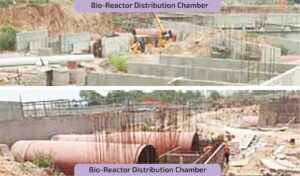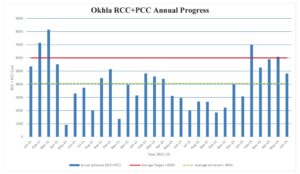While The Yamuna Weeps II- Suez’s Failure To Pick Up The Pace

In May 2019, Delhi Jal Board approved the setting up of Okhla wastewater treatment plant (WWTP) with an objective of cleaning 564-million litres per day (MLD) or 124 million gallons per day (MGD) of wastewater. This facility was envisioned to remove 41,200 kg of organic pollutant load and 61,600 kg of solid load per day from the wastewater that would otherwise fall in Yamuna unabatedly. The contract to build the massive Okhla WWTP was awarded to France based Suez Group. Hopes were high, even leading to promises by elected officials that the Yamuna would be good enough to bathe in, if not drink from, by 2024. For now, the ever shifting deadline is 2025.
The project was conceived to cater to about 40 lakh people (4 million) residing in thickly populated areas of Chandi Chowk, Kashmere Gate, Daryaganj, NDMC areas, Lodhi Colony, Nizamuddin, Okhla, Badarpur, Kalkaji, Malviya Nagar, Katwariya Sarai, Lajpat Nagar, Greater Kailash and locations between Munirka and Badarpur in South Delhi. The failure of Suez has impacted the social and environmental rights of the citizens besides loss of public money. Billions of litres of wastewater had flown into the Yamuna further deteriorating its natural ecology.
Plethora of discrepancies by Suez at Okhla
The IAmRenew investigation found just too many and blatant discrepancies by the contractor which disallowed timely completion of the project.
According to the Progress Report of June 2023 (when Suez India failed on third deadline), the company did not employ sufficient manpower at the project site from the beginning of the project. The WWTP required 1500 workers for construction at the site. The company committed to the authorities that it would deploy 1000 worker which means 1/3rd less than what authorities demanded and this was very less for civil construction and electrical and machinery (E&M) works.
The monitoring authority (PMC) found that Suez India deployed even less than 1000 workers in actual. Hence, first Suez India promised just two-thirds of the actual required workforce requirement and then didn’t adhere to that also. The shortage of workers had a negative impact on the overall construction of Okhla WWTP.
According to a source, the company was carrying out its works with just 500-odd workers. As of June 2023, Suez India didn’t have required number of workers at the site.
The authorities red-flagged the workforce shortage time and again and told Suez India that with less workers it wouldn’t be possible to achieve the project in time. There also had been shortfall of machineries at the site. The matter was discussed at the level of Chief Executive Officer (CEO) of Delhi Jal Board as to how Suez India was missing the targets, but we are unaware if any action was taken against Suez India.

Civil work at snail’s speed
The expansion of Reinforced Cement Concrete (RCC) and Plain Cement Concrete (PCC) has been too slow throughout the project. This delayed the civil work completion and many critical infrastructures couldn’t be accomplished in time. As on June 2023, Suez India was yet to deliver 13,101 cubic meters of concrete (RCC). Concrete work is pending in many segments of WWTP but the majority of the remaining concrete work is in Bio-reactor, Secondary Clarifier and Solar Sludge Drying Bed which are critical for the functioning of the WWTP. Suez didn’t achieve its monthly targets. A break-up is provided in the graph.
The monitoring authority mentioned in the Progress Report, “The contractor has continuously failed to achieve the monthly concreting required and afterwards started revising the monthly target in between the month.”
According to the documents, a review meeting was held by the Secretary, Ministry of Jal Shakti (MoJS) wherein Suez India (the contractor) was asked to build at least 250 cubic meters of RCC per day that would help complete the WWTP by December 31, 2022 (the extended timeline). The total RCC planned for the year was approximately 72,000 cubic meters. But Suez delivered only 38,000 cubic meters of RCC for the project which is just 53% of the target provided by the authorities.

Flurry of incomplete ‘critical’ infrastructure
The Progress Report of June 2023 by the PMC has revealed that Suez India did not complete even those important units in time that are considered ‘critical’ to run the Okhla WWTP project. These critical units include Bio-Reactors, Distribution Chamber for Bio-Reactors, RAS and WAS, Power Generation Unit, Secondary Clarifier, Connecting Channel & Distribution Chamber, Treated Effluent Channel and Digester Control Building. Not just these, the Treated Water Reuse House, Chemical Building and Sludge Treatment Building also stand incomplete. Hence slow civil work actually derailed the entire project.
The discrepancy of Suez India is evident from the fact that Suez promised to start commissioning Liquid Line with treated effluent water from the first day of January, 2023 but it failed. The sewage was not taken into the plant. On the contrary, it was found in January, 2023, that work related with the installation of Treated Outlet Channel, Bioreactors DC, Secondary Clarifiers DC and related structures stood incomplete in various STP units of the WWTP project.
In Bio-Reactor Distribution Chamber, the progress in installation of Motorized Pen Stock Gates is zero. With regards to the DI pipe laying, 150 meters of laying is still awaited. The civil work is not complete and hence, there is zero progress in motorized pen stock gates erection. Despite the requirement of the contract, Suez didn’t conduct DP and RT tests at the site and submit to monitoring authorities. As for the Bio-Reactor Units, the civil work is complete only in five units and four of them still remain to be completed. Diffusers’ installation has not started and MLR pumps have also not been placed.
In the Sludge Treatment Building, mechanical thickeners are not fully delivered at the site. Not a single one of them has been installed. The Progress Report finds that only foundations have been created and only 50% of the valves and piping work is complete.
In the Primary Scum Sump and Pump unit, Swedish firm Xylem supplied four scum pumps but their installation is impossible as the civil work is not complete.
In RAS & WAS Sump, the incomplete civil work has disallowed the installation of pumps. Most of the important installations including piping is incomplete here.
In Treated Water Reuse House, pumps are not installed. The installation of suction pipes and valves have also not started in this part of the project.

Construction of many important structures not even initiated by Suez
It has been found that as of July, Suez India did not even initiate the construction of many of the WWTP’s important sections. These sections include Gas Holder, Gas Flare and Gas Scrubber of Gas Area. There is no progress found in Vacuum Cooling System. The ‘Liquid Line’ is believed to be the most important unit of the WWTP project. In this, the installation of pump systems in primary scum sump is yet to be done by Suez India.
The E&M installations are yet to take place in the Bio-Reactor Chamber that is in a ‘critical situation,’ say the official documents. It’s also the most important unit for the commissioning of the Liquid Line.
The Hydro Testing and Pneumatic Testing have not been completed even at the end of June, 2023. Several beds are yet to be constructed (beds A and B). The hydro testing of important parts of the WWTP lay pending on the part of Suez India that includes inlet screen channels, three different ducts, secondary clarifier distribution chamber, secondary clarifier connecting channel, tertiary filter etc. Civil works in many of the units is incomplete. As per records, concrete work of 3 streams and hydro-testing in four stream bioreactors, out of a total of 9, were pending.
Short supply of critical materials
The Progress Report mentions that some important supplies have also not been received at Okhla site. These include PST Lamella Module, Mechanical Thickener, Gas Lancer, Compressors, Gas Holders, Heat Exchangers and Centrifuge. It has also been found that in crucial review meetings and inspections, concerned Suez India officials looking after the supplies of materials at the Okhla WWTP were not available before the PMC.
Besides, landscaping, inside roadways, pathways and rainwater harvesting system have not been created inside the WWTP premises. The Progress Report is proving to be a report of card of Suez’s comprehensive failures at Okhla WWTP.

The 564-MLD Okhla WWTP has a special place in the scheme of things of both the state and central governments. Currently, sewage generation in Delhi amounts to about 3400 MLD or 750 MGD. Against this, the government-reported sewage treatment capacity stands at about 2400 MLD or 530 MGD. This means that there is significant disparity in sewage treatment and the Yamuna River is forced to bear the brunt of untreated waste.
Yamuna Action Plan: a gist
Yamuna Action Plans (YAP) were created with the objective of creating sewer networks, catching wastewater and treating it before releasing it into the Yamuna river to ensure that river is cleaned. Previously, YAP-I and YAP-II were executed but the pollution level in Yamuna has gone from bad to worse. The river doesn’t have any life in a stretch of 22-km in Delhi; its literally dead.
Now the Central Government has come with YAP-III which envisages construction of three major WWTPs in Okhla, Kondli and Rithala. All of them have missed their multiple extended deadlines and Yamuna continues to bear the brunt of it. A huge quantity of wastewater is out-falling into Yamuna untreated. Okhla WWTP is being built to South Delhi, NDMC area and other parts of Delhi to benefit over 40 lakh residents.
YAP-III is an integral part of the broader initiative to cleanse the Ganga river system, recognizing the vital importance of a clean Yamuna River as a major tributary to the Ganga.
In next article of the exposé series, IAmRenew will disclose more of the shortcomings and malpractices which have led to this sad state of affairs.
To view Part of the series, click here.





I every time uused to study article in news papers buut noww as I amm a uer off
web so ftom now I am using net forr articles, thanks to web.